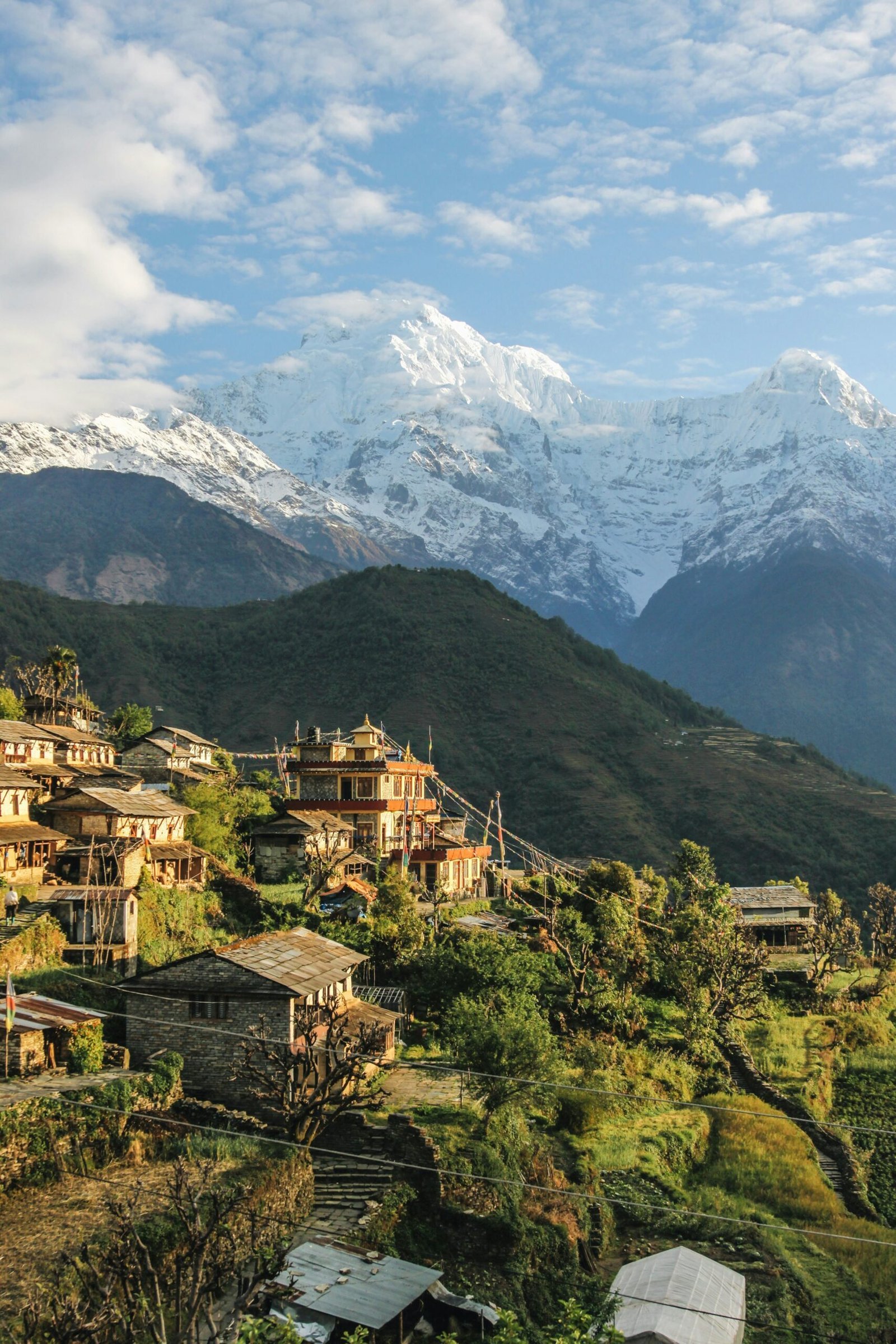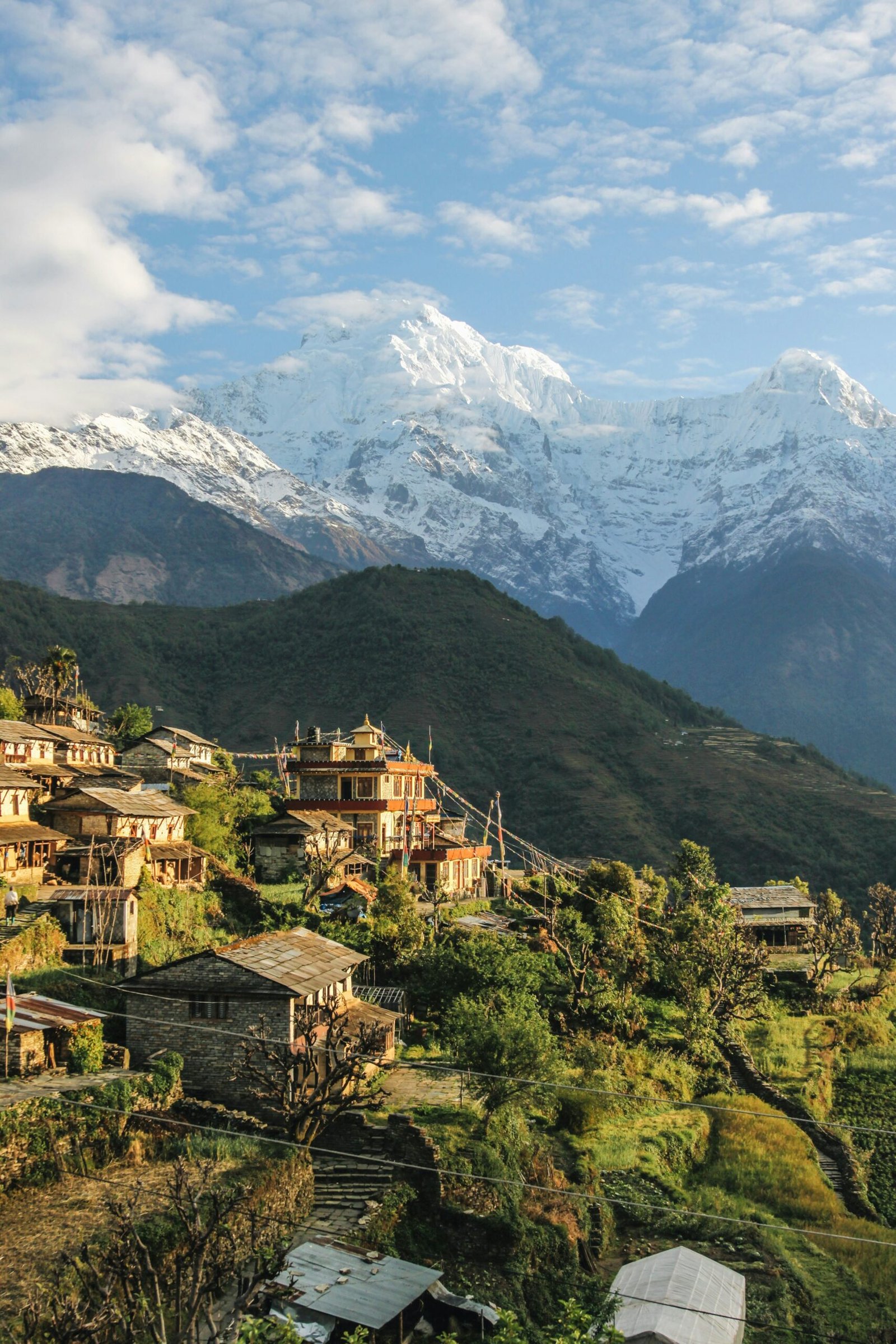
Introduction to Annapurna
Annapurna, a name that resonates deeply within the mountaineering community, stands as a testament to both natural beauty and formidable challenge. Located in the north-central region of Nepal, Annapurna is part of the Himalayas, the world’s highest mountain range. The Annapurna massif is a collection of peaks, with Annapurna I being the most prominent, towering at an impressive height of 8,091 meters (26,545 feet). This makes Annapurna I the tenth highest peak on Earth, a distinction that, combined with its treacherous climbing routes, has cemented its place in mountaineering lore.
What sets Annapurna apart is not just its staggering height but also its daunting difficulty. The peak has a reputation for being one of the most perilous climbs, with an alarmingly high fatality rate. This danger stems from a combination of challenging weather conditions, unpredictable avalanches, and technically demanding routes that require climbers to possess not only physical stamina but also mental resilience. Despite these hazards, or perhaps because of them, Annapurna continues to attract climbers from around the globe, each drawn by the allure of conquering one of the most beautiful yet deadly mountains on the planet.
The significance of Annapurna in the world of mountaineering cannot be overstated. It was the first 8,000-meter peak to be successfully climbed, a feat achieved by a French expedition led by Maurice Herzog and Louis Lachenal in 1950. This pioneering ascent marked a milestone in mountaineering history, setting the stage for future expeditions and inspiring generations of climbers to push the boundaries of human endurance. The challenges posed by Annapurna have earned it a revered status, often described as the ultimate test for climbers looking to measure their skills and determination against one of nature’s most formidable giants.
Historical Background
Annapurna, a name that resonates with mountaineers worldwide, boasts a rich and storied history. The first successful ascent of Annapurna I, the tenth highest mountain in the world, was achieved in 1950 by French climbers Maurice Herzog and Louis Lachenal. This monumental climb marked the first time a peak over 8,000 meters was conquered, cementing its place in the annals of mountaineering history. Despite the triumphant ascent, the expedition took a harrowing turn when both climbers suffered severe frostbite, leading to significant amputations. Their journey was immortalized in Herzog’s book, “Annapurna,” which remains a seminal work in mountaineering literature.
Since this historic ascent, Annapurna has attracted numerous climbers, drawn by its challenging routes and the allure of its unforgiving slopes. The mountain’s formidable reputation is underscored by its high fatality rate, which is among the highest for the world’s 8,000-meter peaks. Despite these dangers, many expeditions have ventured to its summit, contributing to a fascinating tapestry of triumphs and tragedies.
In 1970, the British climber Chris Bonington led an expedition that successfully navigated the south face of Annapurna, a route that was considered one of the most difficult in the Himalayas at the time. This achievement further solidified Annapurna’s status as a mountaineering icon. Another notable ascent occurred in 1987 when a Polish team, led by Artur Hajzer and Jerzy Kukuczka, successfully climbed the east ridge, adding to the mountain’s rich history of exploration and daring.
Over the years, climbers like Reinhold Messner, who completed the ascent in 1985, and Ed Viesturs, who summited in 2005, have continued to push the boundaries of high-altitude climbing on Annapurna. Each expedition contributes to the mountain’s enduring legacy, a testament to the human spirit’s resilience and the relentless pursuit of adventure.
The Dangers of Climbing Annapurna
Climbing Annapurna poses a formidable challenge, with various risks that demand serious consideration from mountaineers. One of the most significant dangers is the high likelihood of avalanches. The mountain’s steep, unstable slopes are prone to sudden snow slides, which can sweep climbers off their feet and bury them under tons of snow. Avalanches are unpredictable and can occur without warning, making them a persistent threat throughout the ascent.
Moreover, the presence of crevasses further complicates the climb. These deep fissures in the glacier are often hidden beneath a thin layer of snow, creating treacherous conditions. Climbers risk falling into these crevasses, which can result in severe injuries or fatalities. Navigating these hidden dangers requires not only technical skill but also constant vigilance and the use of specialized equipment such as ropes and anchors.
Extreme weather conditions also significantly increase the peril of climbing Annapurna. The mountain is notorious for its rapidly changing weather, with climbers often facing fierce winds, heavy snowfall, and freezing temperatures. These harsh conditions can lead to frostbite, hypothermia, and other cold-related illnesses. Additionally, poor visibility caused by snowstorms can disorient climbers, making it difficult to stay on the correct route and increasing the risk of accidents.
Statistically, Annapurna has one of the highest mortality rates among the world’s major peaks. As of recent data, the fatality rate stands at approximately 32%, a stark contrast to other renowned mountains like Mount Everest, which has a fatality rate of about 4%. This alarming figure underscores the extreme hazards climbers face. The combination of avalanches, crevasses, and severe weather conditions makes Annapurna an exceptionally dangerous ascent, testing the skills, endurance, and judgment of even the most experienced mountaineers.
In conclusion, the dangers of climbing Annapurna are manifold and severe. From the constant threat of avalanches to the hidden peril of crevasses and the extremity of weather conditions, each element contributes to the mountain’s deadly reputation. Climbers must approach Annapurna with utmost respect, preparation, and caution, fully aware of the risks involved in attempting this perilous peak.
The Physical and Mental Preparation Required
Climbing Annapurna, one of the most challenging peaks in the world, demands meticulous preparation that encompasses both physical and mental aspects. To tackle this formidable journey, climbers must achieve peak physical fitness. Rigorous cardiovascular and strength-training routines are essential to build the stamina and muscle strength necessary for high-altitude mountaineering. Professional mountaineers often recommend a combination of running, cycling, and weight training to enhance endurance and overall body strength.
Technical climbing skills are equally crucial for a successful ascent. Mastery of techniques such as ice climbing, crevasse navigation, and the use of specialized equipment like crampons and ice axes is indispensable. Prospective climbers should enroll in advanced mountaineering courses and participate in expeditions on less challenging peaks to hone their skills. According to renowned mountaineer Conrad Anker, “Experience on smaller, less perilous mountains is a stepping stone to conquering giants like Annapurna.”
Mental fortitude is perhaps the most critical component of preparation. The journey to Annapurna’s summit is fraught with relentless challenges, including extreme weather conditions, the risk of avalanches, and the ever-present threat of altitude sickness. Climbers must cultivate resilience and the ability to remain calm under pressure. Mental training techniques such as visualization, meditation, and stress management practices can significantly enhance a climber’s psychological readiness. As mountaineering coach Melissa Arnot Reid notes, “Your mind needs to be as strong as your body. Mental preparation is what will carry you through the toughest moments.”
Expert opinions emphasize the importance of comprehensive preparation that integrates physical conditioning, technical proficiency, and mental strength. Climbing Annapurna is not a feat to be taken lightly; it requires unwavering dedication, rigorous training, and an indomitable spirit. Those who undertake this monumental challenge must be prepared to push their limits, both physically and mentally, to stand a chance of reaching the summit.
The Route to the Summit
The journey to the summit of Annapurna is as challenging as it is breathtaking. Climbers typically follow the North Face route, which is the most commonly attempted path. The ascent begins at the village of Tatopani, where adventurers embark on a trek through dense forests and rugged terrains, gradually making their way to the Annapurna Base Camp (4,130 meters). This base camp serves as the launching point for the arduous climb ahead.
From the base camp, climbers proceed to Camp I (5,700 meters), which is situated on the glacier. This stage requires careful navigation through crevasses and seracs, demanding both technical proficiency and unwavering focus. The climb continues to Camp II (6,400 meters), located on a snow plateau. At this altitude, the air becomes noticeably thinner, and climbers must acclimatize properly to avoid altitude sickness.
As the ascent progresses, Camp III (7,200 meters) is established on the upper slopes of the mountain. This section of the route is marked by steep ice walls and treacherous ridges, requiring the use of fixed ropes and ice axes. Climbers must make strategic decisions regarding their pace and the timing of their ascent to minimize exposure to the elements and maximize their chances of success.
The final push to the summit involves navigating through the most technically demanding portion of the climb. From Camp IV (7,600 meters), climbers face a daunting vertical ascent that tests their physical and mental endurance. The summit day is a grueling endeavor, often requiring climbers to start before dawn to ensure they reach the peak (8,091 meters) and return to lower altitudes before nightfall.
Throughout the ascent, climbers must contend with unpredictable weather conditions, the risk of avalanches, and the ever-present threat of altitude sickness. Strategic planning, meticulous preparation, and a deep respect for the mountain are essential for anyone attempting to conquer Annapurna’s formidable heights.
Surviving the Descent
Descending from Annapurna is widely regarded as more perilous than the ascent, presenting climbers with a host of challenges that test both their physical endurance and mental fortitude. As climbers reach the summit, the euphoria of the achievement can quickly be overshadowed by the daunting task ahead: making it back down safely. This phase is often fraught with dangers that are compounded by exhaustion, deteriorating weather conditions, and psychological strain.
One of the primary challenges during the descent is physical exhaustion. After the grueling climb to the summit, climbers are often left with depleted energy reserves, making every step down increasingly arduous. Muscle fatigue can lead to diminished coordination and slower reaction times, heightening the risk of slips and falls. To mitigate these risks, climbers should conserve energy whenever possible, taking frequent breaks and ensuring they maintain adequate hydration and nutrition.
Changing weather conditions also pose a significant threat during the descent. The weather in the Himalayas is notoriously unpredictable, and climbers can quickly find themselves in the midst of a storm or whiteout conditions. It is crucial to monitor weather forecasts closely and be prepared for sudden changes. Carrying appropriate gear, such as extra layers, waterproof clothing, and navigational tools, can be lifesaving.
The psychological strain of the descent cannot be underestimated. After the high of reaching the summit, climbers must shift their focus to the equally demanding task of descending. This transition can be mentally taxing, especially when faced with the realization that the descent can be even more hazardous. Maintaining a positive mindset, staying calm under pressure, and being aware of one’s psychological limits are essential strategies for a successful descent. Climbers should also consider descending in groups to provide mutual support and encouragement.
In summary, surviving the descent from Annapurna requires careful planning, physical stamina, and mental resilience. By anticipating and preparing for the challenges of exhaustion, changing weather, and psychological strain, climbers can increase their chances of a safe and successful return to base camp.
Personal Accounts and Experiences
Climbing Annapurna, one of the most formidable peaks in the world, is an endeavor that etches itself into the memories of those who attempt it. The experiences of climbers offer a profound glimpse into the emotional and physical trials encountered on this arduous journey. Each story is a testament to the human spirit, resilience, and the indomitable will to conquer nature’s challenges.
One climber, John Herrington, recounts his attempt to summit Annapurna in his diary. “The ascent was grueling,” he writes. “The thin air made every step a battle, and the biting cold was relentless. Yet, the camaraderie among our team was the glue that held us together. We shared stories, encouraged each other, and celebrated small victories along the way.” Herrington’s account underscores the importance of teamwork and mutual support in overcoming the mountain’s relentless obstacles.
In an interview, climber Maria Gustafsson shares her experience of reaching the summit. “Standing at the top of Annapurna was an indescribable moment. The view was breathtaking, and the sense of accomplishment was overwhelming. But the journey was filled with emotional highs and lows. There were times when I doubted myself, but the encouragement from my fellow climbers kept me going.” Her words reflect the mixture of euphoria and exhaustion that defines the success of such a monumental achievement.
Another climber, Kevin Patel, highlights the emotional rollercoaster of the climb. “There were moments of sheer terror, especially during the descent. The mountain doesn’t let you relax; it’s a constant test of your mettle. But the friendships forged in those extreme conditions are lifelong. We became a family, united by the shared experience of conquering Annapurna.” Patel’s story emphasizes the deep bonds formed through shared adversity and the lasting impact of such an endeavor.
These personal accounts illustrate that climbing Annapurna is not just a physical challenge but a profound emotional journey. The highs and lows, the camaraderie, and the ultimate sense of accomplishment contribute to the rich tapestry of experiences that define this extraordinary adventure. The mountain, with its formidable beauty and inherent dangers, tests the mettle of each climber, leaving an indelible mark on their lives.
The Allure of Annapurna: Why Climbers Keep Coming Back
Annapurna, one of the most formidable peaks in the Himalayas, continues to draw climbers from around the world despite its notorious reputation. The allure of Annapurna lies not just in its majestic beauty, but also in the prestige and personal growth that accompany the arduous journey to its summit. One of the primary attractions is the mountain’s breathtaking landscape. With its rugged terrain, snow-capped peaks, and panoramic vistas, Annapurna offers a visual feast that is unparalleled. The sheer scale and grandeur of the mountain are awe-inspiring, challenging climbers both physically and mentally.
Another significant factor is the prestige associated with conquering such a daunting peak. Annapurna is known for its high level of difficulty and danger, with a history of avalanches and treacherous weather conditions that have claimed many lives. Successfully summiting Annapurna is a testament to a climber’s skill, determination, and resilience. It is a badge of honor that sets elite mountaineers apart, earning them respect and recognition within the mountaineering community.
Beyond the physical and reputational challenges, climbing Annapurna offers profound opportunities for personal growth. The journey demands immense mental fortitude, pushing climbers to their limits and beyond. The experience fosters a deep sense of self-awareness, resilience, and inner strength. Many climbers describe their ascents as transformative, providing them with a renewed perspective on life and their capabilities.
In the world of mountaineering, Annapurna represents the ultimate test of skill and perseverance. It embodies the spirit of adventure and the human drive to push boundaries. While its dangers are ever-present, the mountain’s allure remains undiminished. Climbers are drawn to Annapurna not just for the challenge it presents, but for the personal and professional growth it promises. In this way, Annapurna continues to be a beacon for those seeking to test their mettle against one of nature’s most formidable giants.



